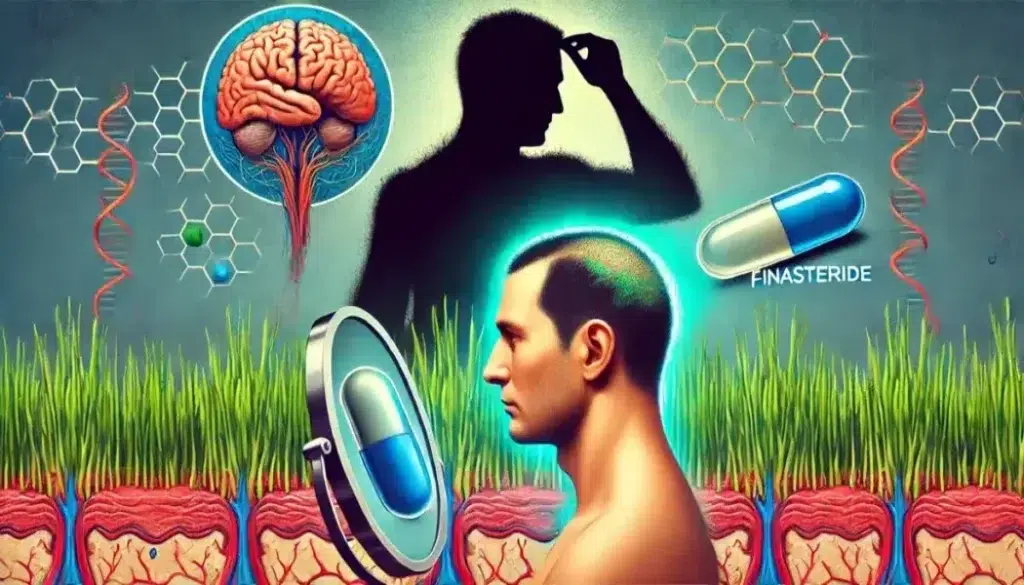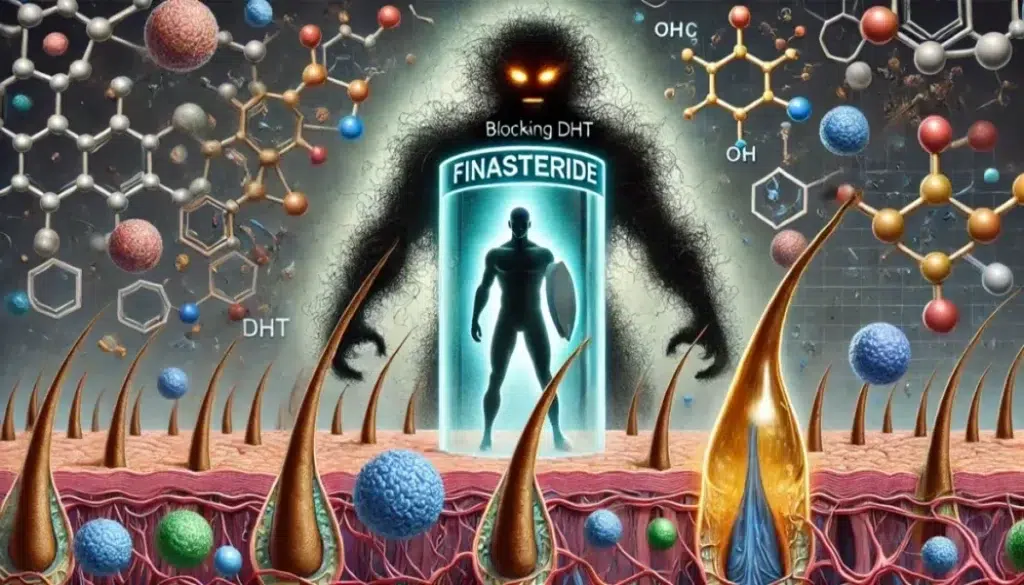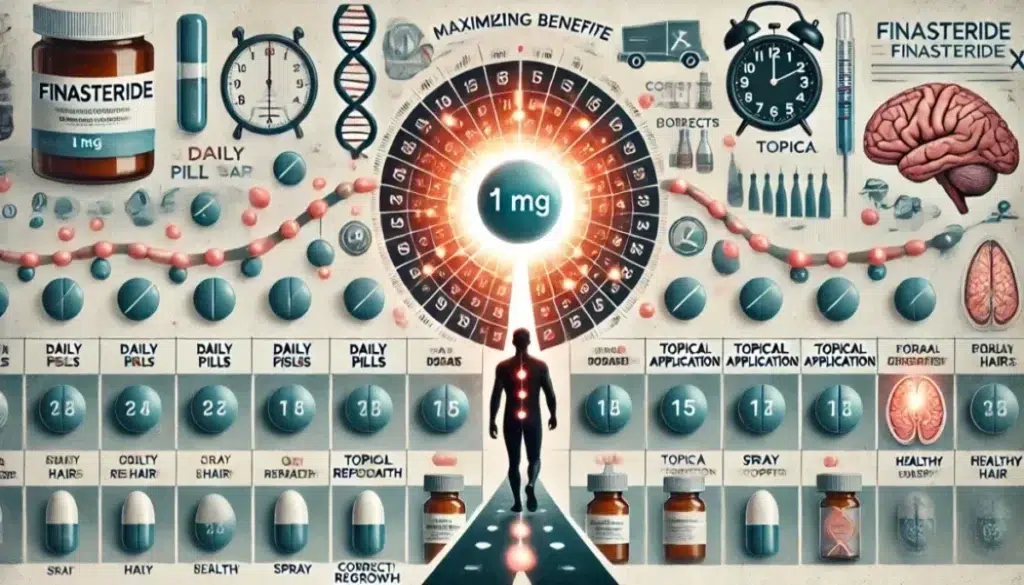Male pattern baldness is like that unwelcome guest who overstays their welcome—many guys deal with it, but not everyone knows what to do about it. This is where finasteride steps in, a handy tool in the fight against hair thinning and loss.
Originally developed for treating prostate issues, finasteride found its niche in the world of hair regrowth. It’s mostly used to tackle male pattern baldness, turning into a go-to option for those noticing more scalp than hair in their reflection.

The appeal of finasteride lies in its targeted approach. Rather than being a catch-all remedy, it offers a focused solution by addressing the underlying biological processes causing hair loss. This makes it particularly attractive for those keen on reclaiming their youthful mane.
🧪 The Science Behind Finasteride: Mechanisms and DHT Blocking
Finasteride’s superpower lies in its ability to block dihydrotestosterone, or DHT for short. This pesky hormone is infamous for shrinking hair follicles and slowing down hair growth, leading to that thinning look nobody’s really aiming for.
By targeting DHT, finasteride works like a bouncer at a club, keeping the troublemaker hormone from doing its damage and allowing hair follicles to hang onto strands longer. In essence, finasteride helps preserve what you’ve got and makes the environment a bit friendlier for new hair growth too.

Understanding DHT’s impact on your hair gives you insight into why your hair might be making a premature exit. This hormonal interaction is a key factor in male pattern baldness, making finasteride’s role even more
⏳ Timelines and Longevity of Results: What to Expect with Finasteride
Patience is key when you’re on finasteride because it’s not an instant fix like waving a magic wand. It typically takes a few months to see solid results. Most folks start noticing changes around the three to six-month mark. The trick is to keep your expectations realistic and the commitment strong.
Once you’ve hit that sweet spot where the hair’s showing its stuff, maintaining those gains becomes crucial. Stopping finasteride can reverse progress since DHT levels could climb back up, renewing its follicle-shrinking mission.
Everyone responds differently to treatments, and finasteride is no exception. Some see faster results, while others might need a little more time. Factors like age, genetics, and overall health can sway the timeline, so stay on course and consult with a doctor for personalized advice.

Regular check-ins with a healthcare provider ensure that you’re on track and help tweak the approach if needed. Finasteride is mostly about playing the long game, and with consistent use, you’ve got a good shot at solid results.
💊 Proper Usage and Dosage: Maximizing Benefits from Finasteride
Getting the most from finasteride means nailing the dosage and sticking to a routine. A standard daily dose for treating hair loss is typically 1 mg, but always listen to your healthcare provider for guidance tailored to you.
You’ve got options on how to take it, with oral pills being the most popular. These nifty little tablets are straightforward when it comes to hair regrowth, making them a convenient choice for many.
However, there are also topical applications if popping pills isn’t up your alley. While not as widespread for hair loss, they can be an alternative route, especially if you’re thinking about side effects and localized treatment.
Consistency is everything. It may take time to see those luscious locks return, so staying the course with daily dosing is essential. Missed doses here and there? It happens, just try not to make it a habit.

Duration of treatment is another piece of the puzzle. Many users continue finasteride indefinitely to maintain results, but evaluating progress with a healthcare professional is wise to determine when to keep going or step back.
🌿 Finasteride Isn’t a Magic Pill – What Else Affects Hair Growth?
While finasteride can do wonders in blocking DHT, there are other forces at play that can either support or sabotage your hair recovery journey.
🧠 Stress – High stress levels can increase cortisol, a hormone that not only impacts overall health but also accelerates hair loss. If you’re constantly under pressure, even finasteride might not be enough. Learning how to manage stress through sleep, mindfulness, or light exercise could make a big difference in your results.
🥗 Nutrition – Your hair relies on key nutrients like biotin, zinc, vitamin D, and iron to grow strong and healthy. Without the right fuel, finasteride can’t perform miracles. Incorporating a balanced diet or considering targeted supplements can enhance the results.
🧪 Supplements – Some supplements specifically support hair health and might boost the effects of finasteride. Think of things like saw palmetto, collagen, or marine-based complex formulas. While they’re not a replacement for medication, they can be part of a supportive combo.
🌍 Environmental Factors – Pollution, harsh weather, and even hard water can impact the scalp and hair condition. These elements often go unnoticed but can quietly hinder progress by irritating the scalp or damaging follicles.
(https://hairgrowgenius.com/air-pollution-and-scalp-health-research/)
💧 Hair Care Routine – Using gentle, DHT-friendly shampoos and nourishing conditioners helps keep the scalp healthy and primed for regrowth. Avoiding harsh sulfates and maintaining a clean, hydrated scalp can complement the internal work that finasteride is doing.
By addressing these external and lifestyle factors, you’re building a solid foundation for finasteride to actually work. It’s all about synergy—tackling hair loss from the inside and the outside.
⚠️ Safety and Side Effects: Navigating Potential Risks of Finasteride Use
While finasteride can be a hair savior, it’s essential to keep an eye on potential side effects. Common ones might include a drop in libido or changes in sexual function. These are important to monitor, though many folks use finasteride without trouble.
Engage in regular chats with your healthcare provider to weigh benefits against any risks. This can help decide if finasteride suits your particular case or if some adjustments or alternatives might be better for you.
In rarer situations, users might experience other side effects like depression or allergic reactions. Reporting anything unusual to a doctor makes it easier to deal with these issues swiftly.

Safety protocols are important. Regular follow-ups can keep tabs on any developments and ensure that you’re getting the best results without unwelcome surprises. Check-ins provide a chance to adjust dosage or consider additional treatments if necessary.
Overall supervision by healthcare professionals brings peace of mind, reinforcing that you’re not in this hair journey alone. Personalizing the approach under expert guidance helps maintain focus on the end goal: a healthier scalp and fuller hair.
Stay with us — the best is yet to come.
By following our advice, you’re doing the most you can for your hair.
Be the first to know when we publish new guides, tests, and proven strategies for stronger, healthier hair.
👉 Visit the About Me page to learn more about my journey, mission, and why helping people with hair health is so personal to me.
Want healthier, stronger hair? Discover 8 science-backed habits that protect your scalp and boost natural growth. Get your free PDF guide today!
Disclaimer: This article is for informational purposes only and is not a substitute for professional medical advice. Sensitive claims are supported with scientific references, and full product details can always be found on the official websites of the respective manufacturers or distributors.
Some links in this article are affiliate links. If you choose to make a purchase through them, I may earn a small commission at no extra cost to you — helping me keep HairGrowGenius running. Thank you for your support!

✅ FAQ – Finasteride for Hair Loss: How It Helps Treat Male Pattern Baldness
❓ How long does it take for finasteride to show visible results on hair growth?
Most users begin to notice reduced hair shedding within 3–6 months of consistent use, with visible regrowth typically appearing after 6–12 months. Patience is key—finasteride works gradually by shifting hair follicles back into the growth phase.
❓ Can I stop taking finasteride once my hair improves?
Discontinuing finasteride usually leads to a reversal of gains within several months, as DHT levels rise again. To maintain results, ongoing use is typically necessary. It’s not a one-and-done treatment—it’s a commitment.
❓ Does finasteride work on receding hairlines or just crown thinning?
Finasteride is FDA-approved for vertex (crown) thinning but has shown off-label benefits for frontal hair loss and receding hairlines in many men. However, results in the front are typically less dramatic and more variable.
❓ Can finasteride be combined with other treatments like minoxidil or microneedling?
Yes, combining finasteride with topical minoxidil or microneedling can enhance hair regrowth by targeting different pathways—hormonal vs. vascular/mechanical. This combo is often used in clinical practice for more robust results.
🧾 Last updated: June 2025 based on latest research.


Leave a Reply